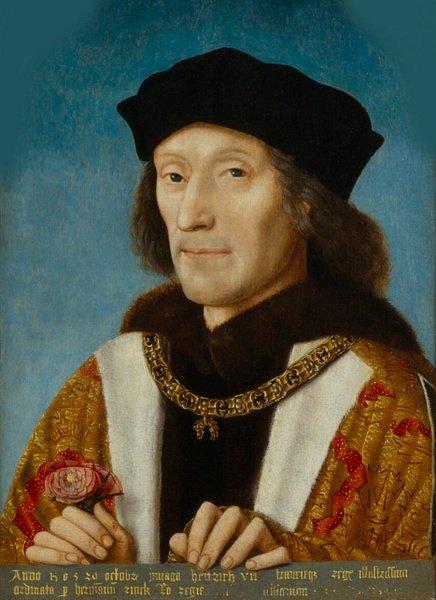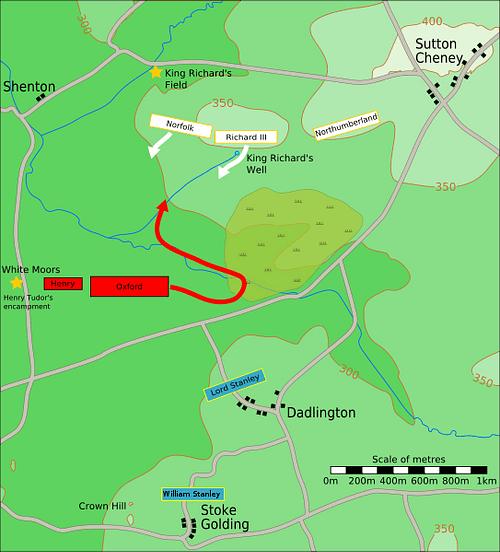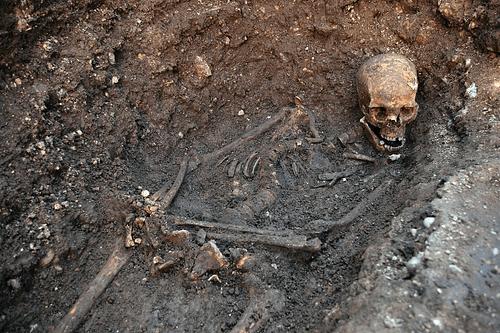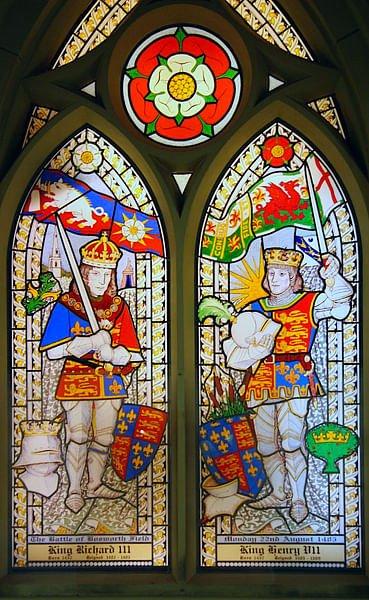At the Battle of Bosworth (aka Bosworth Field) in Leicestershire on 22 August 1485 CE, the Yorkist king Richard III of England (r. 1483-1485 CE) faced an invading army led by Henry Tudor, the figurehead of the Lancastrians. It was to be a decisive engagement in the long-running dynastic dispute known to history as the Wars of the Roses (1455-1487 CE). Henry won the day, largely because some of Richard's allies either switched sides or remained inactive during the battle. The king was unseated from his horse and butchered as he made a last-ditch attempt to personally strike down his direct opponent for the throne. The victorious Henry Tudor then became King Henry VII of England (r. 1485-1509 CE). The Battle of Bosworth used to be considered the end of the Middle Ages in England but, even if modern historians tremble at such picturesque and arbitrary cut-off points, the battle remains a pivotal event in English history. Bosworth has gripped the popular imagination ever since, largely thanks to William Shakespeares' play Richard III, which has immortalised that day in August when the last English king to be killed on the battlefield fell.
The Wars of the Roses
When Edward IV of England (r. 1461-1470 CE & 1471-1483 CE) died unexpectedly on 9 April 1483 CE, his young son became king. Edward V of England (r. Apr-Jun 1483 CE) was only 12 years of age and so he had a regent, his uncle Richard, Duke of Gloucester. The duke, given the title Lord High Protector of the Realm, imprisoned Edward and his younger brother Richard in the Tower of London where they became known as the 'Princes in the Tower'. The boys were never seen again and Duke Richard made himself king in July 1483 CE. The king was widely accused of having killed his nephews in the most despicable act of the Wars of the Roses, even if the exact causes of their deaths remain a mystery.
Even Yorkists supporters were shocked at this turn of events, and the old foe the Lancastrians had not gone away completely. The latter group, still eager to claim the throne for themselves, were now led by their best hope, the exiled Henry Tudor, Earl of Richmond (b. 1457 CE). Henry was, through the illegitimate Beaufort line, a descendant of John of Gaunt, a son of Edward III of England (r. 1327-1377 CE). It was not much of a royal connection but the best the Lancastrians could produce after years of purges by the Yorkist king Edward IV. Taking advantage of the discontent at Richard's court, Henry gathered around him some impressive support: the Woodvilles (family of Edward IV's queen, Elizabeth Woodville), nobles not happy with Richard's distribution of estates or favours, and Charles VIII of France (r. 1483-1498 CE), eager to cause any disruption that limited England's power abroad, particularly in Brittany. After an invasion fell apart due to bad planning in November 1483 CE, news of the death of Richard's son and heir Edward in April 1484 CE boosted the Lancastrian cause. It was now a case of toppling Richard, and the throne could be theirs.

The Opposing Armies
On 1 August 1485 CE, the Wars of the Roses reached boiling point when Henry Tudor set off from Brittany and landed with an army of French mercenaries at Milford Haven in South Wales, a force perhaps no bigger than 2,000-3,000 men and including only around 400-500 Englishmen. Henry's army swelled in numbers over the next week as it marched through Wales along the River Severn, to Shrewsbury, Coventry and finally the area around Leicester. The Welsh baron Rhys ap Thomas was offered the carrot of the Lieutenancy of Wales should Henry win, and this boosted the rebel army by another 800 men. A further 500 soldiers came with William ap Gruffudd via north Wales and 500 more with Gilbert Talbot, uncle of the Earl of Shrewsbury. Now with an army of perhaps 5,000 men, Henry had at least a chance of toppling the king and his much larger army if he could persuade some of Richard's men to defect either before or during the forthcoming battle.
Another weakness of Henry's army, besides numerical inferiority, was the fact that many of his fighting men were conscripted tenant farmers with only limited battle experience. Neither were they particularly well-equipped and so were mostly archers or spearmen. Still, Henry did have experienced mercenaries from France and Scotland who were armed with shields, swords, and pikes, and there were units of medieval knights, the heavy cavalry. In terms of command, Henry was a mere novice but he could call on the experience of his uncle Jasper Tudor, Earl of Pembroke, John de Vere, the Earl of Oxford, and the leader of his French mercenaries, Philibert de Chandée.
Richard, on hearing news of Henry's invasion force, left Nottingham Castle and assembled his supporters. The king's army consisted of a similar mix of troops to Henry's but with slightly better equipment and certainly more cavalry. Another advantage was that Richard had some heavy artillery pieces while Henry had only a number of light field guns. Unfortunately, as the king had been unsure where Henry Tudor's invasion might land, he had placed loyal nobles and troops around England, and this meant he could not command as large an army as he would have liked at Bosworth. It may also have been the case that Richard preferred to engage Henry as soon as possible before he had a chance to swell his numbers with even more defectors from the Crown.

Although commanding a superior total force of some 8,000-12,000 men, Richard would be, just as Henry hoped, deserted at the last moment by some of his key allies. Amongst the most unreliable was Sir William Stanley, whose nephew Lord Strange was being kept hostage by Richard precisely to ensure loyalty. Stanley commanded 3,000 men at Bosworth and so his support would prove vital to whoever he gave it to. Another dubious ally of Richard's was Henry Percy, Earl of Northumberland, who would even refuse to engage his troops until he had a clear idea which side was going to win the day in the battle that would decide a kingdom. Richard was very likely aware of the treachery in the air and that now his past dark deeds would come back to haunt him. Shakespeare is, then, perhaps not far from the truth, at least in spirit, in his famous scene from Richard III when, the night before the battle, the troubled king is visited by the ghosts of all those nobles he had supposedly murdered. Perhaps Richard's conscience really was toying with his nerves on the eve of Bosworth:
My conscience hath a thousand several tongues,
And every tongue brings in a several tale,
And every tale condemns me for a villain…
There is no creature loves me;
And if I die, no soul will pity me.
(Richard III, Act 5, Scene 3)
Despite the dubious hand that fate had dealt him on this day, the king did have one ace to play: himself. Richard was an experienced field commander, having fought with aplomb alongside his brother Edward at the battles of Barnet and Tewkesbury in 1471 CE. In 1482 CE, Richard had also led an army into Scotland, occupied Edinburgh for a time and won back control of Berwick for the English Crown. This was a king more than capable of defending his throne on the battlefield, and even Shakespeare has Richard perk up a bit on the morning of the battle: "Conscience is but a word that cowards use…Our strong arms be our conscience, swords our law" (ibid). Indeed, according to one anonymous eyewitness, recorded in a letter of 1486 CE, the king was determined to settle the issue this day. He stated "God forbid I yield one step. This day I will die a King or win" (quoted in Turvey, 134).

Battle Lines
Henry's force met the king's army at Market Bosworth, a small village near Leicester on 22 August 1485 CE. The king's army, which had arrived first, had formed at the top of Ambian Hill with Richard himself in command and wearing his battle crown and royal arms. The spot commanded the whole battlefield and had the added advantage of marshland protecting the king's flank. Without eyewitness accounts and only conflicting later reports, the exact details of the three-hour battle are not known.
Henry's forces may have charged first and then Richard's forward lines raced down the hill to meet what seemed a much smaller enemy army. Henry's troops stood their ground but reformed into a wedge shape which pushed back Richard's first attack. The king, who had remained on Ambian Hill, then noted that Henry was at the very rear of his lines with only a small number of troops around him. Deciding the quickest way to end the battle was to head straight for Henry and cut him down, Richard charged down the hill with his heavy cavalry. He may have been forced into this reckless act by the refusal of the Earl of Northumberland to mobilise his own force from the rear and into the central action. The duplicitous Northumberland, as it turned out, would remain inactive throughout.
Richard's Glorious Death
The king fought bravely and perhaps a little foolishly in his efforts to kill Henry Tudor with his own sword. Richard, although managing to strike down Henry's standard-bearer, had his horse cut from under him - hence, Shakespeare's famous line "A horse! A horse! My kingdom for a horse!" (Act 5, Scene IV). The king was killed when Sir William Stanley finally decided who to support and directed his 500-cavalry force to further encircle Richard, cutting him off from his own troops. The king received many wounds but was finally felled by a Welsh pikeman, one Rhys ap Maredudd according to one chronicler. Richard was the first English king to be killed in battle since Harold Godwinson (r. Jan-Oct 1066 CE) at the Battle of Hastings in 1066 CE, and the last English monarch to fall on the battlefield. When the king had fallen, the Yorkists fled the scene having already suffered heavy casualties, amongst whom was the Duke of Norfolk. Henry had won the battle and, as Richard had no heir, also the kingdom.
Aftermath
The dead king's body was slung across the back of a mule and displayed, naked except for a piece of cloth, in the Church of Saint Mary in Newarke near the battleground and then buried at Greyfriars Abbey, Leicester. In 2012 CE archaeologists in Leicester excavated the site where they believed the ruins of Greyfriars Abbey were buried. Digging down from what was on the surface a car park, they revealed a skeleton which was male, had many marks of sword or dagger injuries and, most intriguingly, had suffered from curvature of the spine, one of Richard's supposed ailments. Researchers at the University of Leicester conducted DNA testing and confirmed that, with a probability of 99.9%, this was the skeleton of Richard III. The remains were eventually reinterred in a new purpose-built tomb in Leicester Cathedral.

Back in the 15th century CE, the victorious Henry Tudor, according to legend, was given Richard's crown, found by Stanley beneath a hawthorn bush at Bosworth Field. The new king was crowned Henry VII of England (r. 1485-1509 CE) on 30 October 1485 CE. Loyal followers were rewarded such as Stanley who was made Earl of Derby, Constable of England, and allowed to keep the rich hangings from Richard's tent at Bosworth. In contrast, such figures as the Earl of Northumberland got their comeuppance as Henry imprisoned them, presumably deeming them untrustworthy. The former Yorkist queen Elizabeth Woodville (c. 1437-1464 CE), on the other hand, was given an honourable retirement in Bermondsey Abbey, then just outside London. When Henry married Elizabeth of York, daughter of Edward IV in 1486 CE, the two rival houses were finally united and a new one created: the Tudors. Henry still had to face some challenges, notably, a Yorkist revival centred around the pretender Lambert Simnel, but this was quashed at the Battle of Stoke Field in June 1487 CE. The Wars of the Roses were finally over, half the English barons had been killed in the process, but England was at last united as it left the Middle Ages and headed into the modern era.
